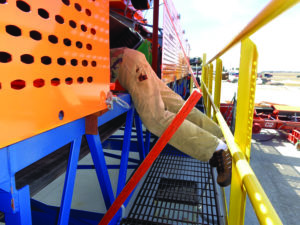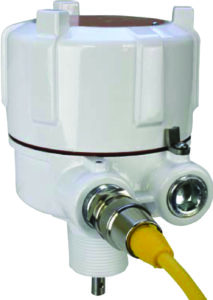
Never do this: confined space entry by untrained personnel is a formula for serious injury. The photo appeared with attribution to Martin Engineering and that company would like to emphasize that it does not condone or promote unsafe practices.
Coal operations rely on silos and bins to store raw and clean coal. Silos, chutes and bulk storage vessels will become clogged or suffer from bridged material. These coal handling and storage systems are connected by a network of conveyors and chutes, which suffer from similar problems on a smaller scale. These problems usually occur at the most inopportune time and can bring an operation to its knees until its resolved.
The coal clearing experts at Mole Master, divide these types of projects into three categories: Low degree of difficulty (LDD), medium degree of difficulty (MDD) and high degree of difficulty (HDD). They said approximately 60% of the projects fall into the MDD category, and the other 40% fall into either the LDD or HDD levels. They advise that no project, regardless of size, should be allowed to start without first making sure that all personnel are properly prepared and trained.
Safety is a high priority and mine operators should evaluate any contractor closely to determine their level of expertise and safety training. Mole Master suggests reviewing the company’s Workers’ Compensation Experience Modifier (EMR) rate. Many companies believe that an EMR rate higher than 1 is unacceptable. All Mole Master technicians are Mine Safety and Health Administration (MSHA) 5000-23 certified.
LDD projects are often handled manually by the plant’s in-house maintenance crew. Common practices on these types of projects include poking, rodding, jack hammering, air lancing, sledge hammering or, in some cases, the use of these same techniques combined with confined space entry. Mole Master cautions that unclogging even the smallest or simplest of storage vessels presents risks that must be anticipated and prepared for to eliminate serious injury or death.
MDD projects require a more advanced understanding of material handling and flow characteristics coupled with equipment such as Mole Master’s Junior 360 whip system or Arch Master drill, which can be provided as a contracted service or purchased or rented for a specific project and operated by trained in-plant personnel. These projects typically involve clearing silos measuring less than 40 ft in diameter x 100-ft high with relatively straightforward access and bridged, arched or compacted materials that are not in extremely high volumes or in extremely hard or hydrated condition. These projects can generally be completed in a few days time using proper techniques and equipment where they might take weeks using LDD equipment and manual labor.
An HDD project requires the ultimate level of experience, equipment and safety that can only be accomplished by contracting a company that provides highly trained technicians and equipment who have conquered these types of projects in the past. In addition to equipment such as Mole Master’s proprietary BIG MOLE’ system. Mole Master said it is the only bulk storage vessel cleanout/unclogging company capable of providing complete turnkey services for high-degree difficulty projects on a safe, reliable and consistent basis.
Safe Confined Space Entry
An estimated 7% of the U.S. fatalities recorded by MSHA between 1995 and 2011 occurred in a confined space, according to Martin Engineering. To reduce that number, they advise mine operators to understand how a confined space is defined, and consider what to do to prevent serious injuries.
“Clearing extensive buildup often involves confined space entry, but the consequences of untrained staff entering a chute, silo or hopper can be disastrous, including physical injury, burial and asphyxiation,” Product Engineer, Martin Engineering, Daniel Marshall said.
Confined space is an area not designed for continuous employee occupancy and large enough for an employee to enter and perform assigned work, but with limited or restricted means for entry or exit.
Many manufacturers offer systems and products that can reduce the need for confined space entry. Examples would include:
Modular chute designs with abrasion-resistant liners;
Chutes that hinge open and lay down for liner replacement;
Skirtboards with external liners;
Belt cleaners that can be serviced without confined space entry;
Flow aids such as air cannons and vibrators to reduce buildup; and
Modular air cleaners for specific locations rather than centralized dust collection.
Rules regarding confined space entry vary greatly depending on the country, even down to the state, province or prefecture level. As always, regional and local codes should be identified and followed, but general rules can be drawn from regulations established in major industrial markets such as Australia/New Zealand, Canada and the United States. Commonalities between governmental regulations provide employers with a measured approach to safety. These procedures include:
Prior to Starting the Job:
Review the permit and the job-specific work procedures.
Gather and inspect all necessary PPE.
Test and/or calibrate any safety gear, test instrumentation or communication tools.
If a current Job Safety Analysis (JSA) or safety check list does not exist, perform a risk assessment.
Hold a pre-job meeting making sure all workers are aware of the hazards and safe work practices.
Conduct proper tests for toxins, vapor, dust levels, oxygen levels and material-specific hazards.
Perform as much cleaning and maintenance as possible outside of the vessel.
Post completed confined space entry permit outside of the vessel.
Isolate contaminants and moving parts to prevent the accidental introduction of materials.
Proper lock-out/tag-out/block-out/test-out procedures must be completed and documented prior to entry.
During Procedure:
Perform maintenance/cleaning using non-toxic substances such as water and avoid using heat/fire in the confined space. Never use oxygen to purge a confined space, as this can create a fire and explosion hazard.
Provide ventilation if possible.
Select personal protective/safety equipment such as safety helmet, gloves, hearing protectors, safety harness, and lifeline and breathing apparatus.
Assign a trained observer to monitor the procedure and internal conditions, and provide escape assistance if needed.
Practice fast evacuation of the confined space.
“Over time, well-designed access improves safety and saves money,” Marshall added. “Safe access that is carefully located and adequately sized will increase dependability and also reduce the downtime and associated labor required for maintenance.” He advises that companies consider equipment designs that minimize the need for confined space entry, including improved access doors, vibrators, air cannons or silo cleaning services. “Conveyor systems that are properly outfitted with appropriate cleaning and material discharge equipment create a safer workplace, while experiencing longer life and less downtime,” he concluded.

A QD sensor saves replacement time.
Silo Monitoring Trends
According to BinMaster, two silo monitoring technologies emerged over the years that are making life easier for plant managers. One is an acoustics-based sensor that uses sound waves to measure multiple points on the material surface in the silo. The other (wireless technology) revolutionized non-contact radar, using the 80-GHz frequency band to overcome the short-comings of its predecessors.
The proliferation of wireless technology is changing the landscape at industrial plants. Wireless devices were the missing link between sensors and the software that could provide workers with the data to do their jobs better. Sensors are now more robust and durable. At the same time, the price of these devices has come down significantly — making a connected plant affordable.
Now, any phone that has internet access can become a powerful business management tool. Personnel can now access their silo inventory data from their phone whether they are at the plant or offsite.
Accessing silo levels in real-time is a real time saver. Digital panel meters have come a long way in design features and are very affordable, according to BinMaster. LED technology makes them easy to read even in bright sunlight and dust. They are used at loadouts by drivers and by personnel managing scheduling and production alike.
Industrial plants are tough on level sensors. This dictates that equipment is maintained on a regular basis and occasionally replaced altogether. Adding a quick disconnect (QD) has become a real time saver. These inexpensive accessories can take the tedious task of hard wiring sensors and turn it into a literal plug-in operation. No licensed electrician needed. Staff spend less time installing, replacing, or maintaining a sensor. QD connectors can be purchased separately for retrofit, or some manufacturers will ship new sensors with the QD option already installed.




